Comparison of two GPS Data Loggers

Many of us love hiking. We bring tons of photographs, then in the long evenings we pick, trying to choose the best ones, so that we have something to show to our friends and acquaintances. But some of this is not enough. Sometimes you want, you know, to plunge into the memories a little more fully. That would be to record the route and then watch it on the map or in Google!
The first thing that comes to mind is the navigator. We will not touch on the specific implementation, it can be a specialized device, and an application on a smartphone. However, every walker knows: the batteries sit down at the most inopportune moment (and the more serious ones, breaking off the handle of a toothbrush, will also remember the weight of the backpack). And it is not always possible to change or charge these same batteries. Yes, and the presence of the card is not always necessary, I just want to know the path traveled.
')
In our last equestrian expedition, comrade had a navigator Gramin Oregon 450, on which we wrote the track. Analyzing the track turned out to be a very exciting experience! You can see the speed of movement, and then remember where the trotters were, where the gallop was doing, and where they walked along with steps, where they watered the horses and where the sites did. And if you consider that you can “attach” photos to this data and even make a beautiful .kmz file with marks and photos! .. In general, there is room for imagination.
Henceforth, it was decided to "write" all trips and I began to search for the device.
To begin with, I defined the criteria for the required device:
- maximum compactness;
- only logging, without navigation;
- maximum battery life;
- Set the POI button (if possible, but necessary).
The global ebay market and the "electronic" Cherkizon "AliExpress were exploded. On DealExtreme, I didn’t even go, because I want a reliable device, preferably from a reputable manufacturer. Ebay'e is dominated by auto / children / pets tracking devices with the ability to get the current location of the object via GSM-channel. AliExpress "promotes" DVRs. However, devices from the final set, to which I arrived, can be found both there and there. But the most complete "catalogs" with more or less imputed descriptions are located here and here .
Strangely enough, but the information on such devices is rather small, although it turned out that the idea of linking photos to the coordinates of the location of the shooting attracts many people. The network is full of descriptions of such services, even at Habré this issue was discussed. But I almost did not find a detailed review of the functionality of the glands.
In general, after a long dig on the manufacturers' websites, on Youtube in particular, and on the Internet in general, personally, my choice fell on the following devices:
1. Holux M-241c
2. Holux M-1200E
3. GiSTEQ PhotoTrackr Mini (DPL900)
4. Columbus V-990
Number 1 "dropped out of the fight" for a quite prosaic reason: there is nowhere to buy. There is a model without an index "c", with the transfer of coordinates via Bluetooth, but I don’t need it at all, only eats away battery life, and I’ve read some rumors that recently the quality of devices has become completely different and many have complained about large errors in determining location . In addition, how much I was not looking for, but I still did not understand whether it is possible to put a POI point on this device. Well, the MTK (MediaTek) chip of the first generation, according to reviews, is rather slow and naughty in terms of power supply (at least in comparison with the generation chips of the second).
Very sorry! After all, a beautiful toy, judge for yourself: it works from an AA battery, there is a display indicating the time received from the satellite (one shot and you know exactly the time shift of your camera relative to the Logger).
Number 2 could not be found on sale either (I repeat, I searched in “decent” stores with courier delivery).
Number 3 on the official site is no longer for sale. It was possible to find its upgraded version on a more modern SiRF Atlas IV chip - the Canmore GT-730FL-S .
In the end, two devices were purchased: the Columbus V-990 and the Canmore GT-730FL-S, in which this table of GPS chip comparisons helped a lot.
Columbus V-990:
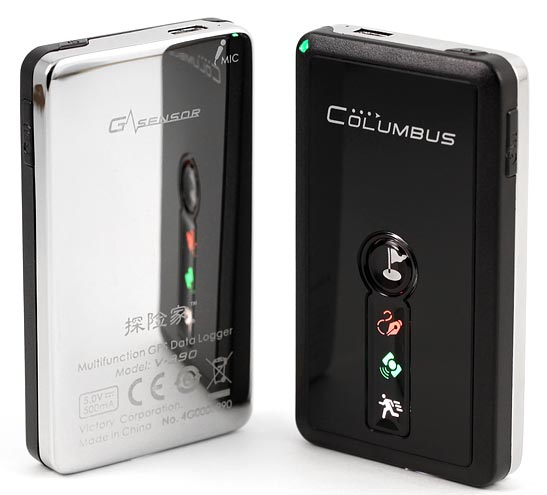
The device is definitely beautiful. The back polished metal surface and velvet cover make it look like a lighter. Charging takes place using the mini-USB connector. And this, alas, its only purpose is that it is impossible to obtain data on it (although the D + and D- contacts leave the connector somewhere). The “heart” of the device is the 18th series PIC microcontroller.
The advantages include the second-generation MediaTek GPS chip (MTK 3329), capable of working with 66 satellites (?!), A motion sensor (which disables recording of a track at rest), a 1000 mAh battery, the possibility of not only put tags, but also make them voice prompts, as well as the ability to install a memory card up to 2 GB, which gives us just an incredible amount of space for recording tracks. True, the device does not work without a memory card, it works more precisely, but there is no place to write a track. And having disassembled the device, we will see that the terrifying quality of voice tag recording is due to the fact that the hole in the case and the microphone on the board are far from each other, as “A” from “I”:
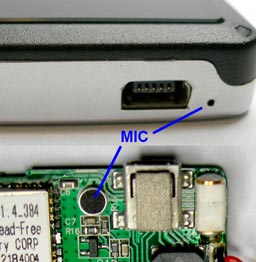
By the way, the device can be transferred to the so-called "Spy mode", in this mode the device wakes up after a certain period of time (set in the settings), saves its coordinates and again safely "falls asleep" until the next time. True, I myself did not check this mode, since there was no interest.
Of the minuses should be noted the following:
- the display "goes blind" in daylight, becoming almost unreadable;
- to set a POI with a voice tag, a separate button is used, it is rather small, located on the side and with a small stroke;
- when recording a voice tag, setting a point in the log occurs after the button is released (that is, after recording), this is not essential when walking, but if you move quickly, then during this time you may be far from the place you need to mark;
- If you overdo the POI setup button longer than necessary, the recording of the new track will begin.
Canmore GT-730FL-S:

Externally, this logger looks like a thick flash drive. Body material - plastic. In general, everything is pretty decent, except that there is no such gloss as that of Columbus. The device is charged via USB, connecting as a regular USB flash drive. The manufacturer indicates the battery capacity at 450 mA / h.
SiRF Atlas IV chip works with satellites, 48 satellite support is announced (GPS and Galileo).
To extract data, you need to install a virtual COM port driver that emulates the STM32 microcontroller, also the “heart” of this device. The data (tracks) are extracted either by the program from the manufacturer ( CanWay ) or by the program from the “original” (GiSTEQ PhotoTrackr Mini (DPL900)) - PhotoTrackr . However, it also reads gpsbabel , but I didn’t find the exact launch parameters (and I’m not really looking for it, to be honest).
I will give a few photos of the entrails.
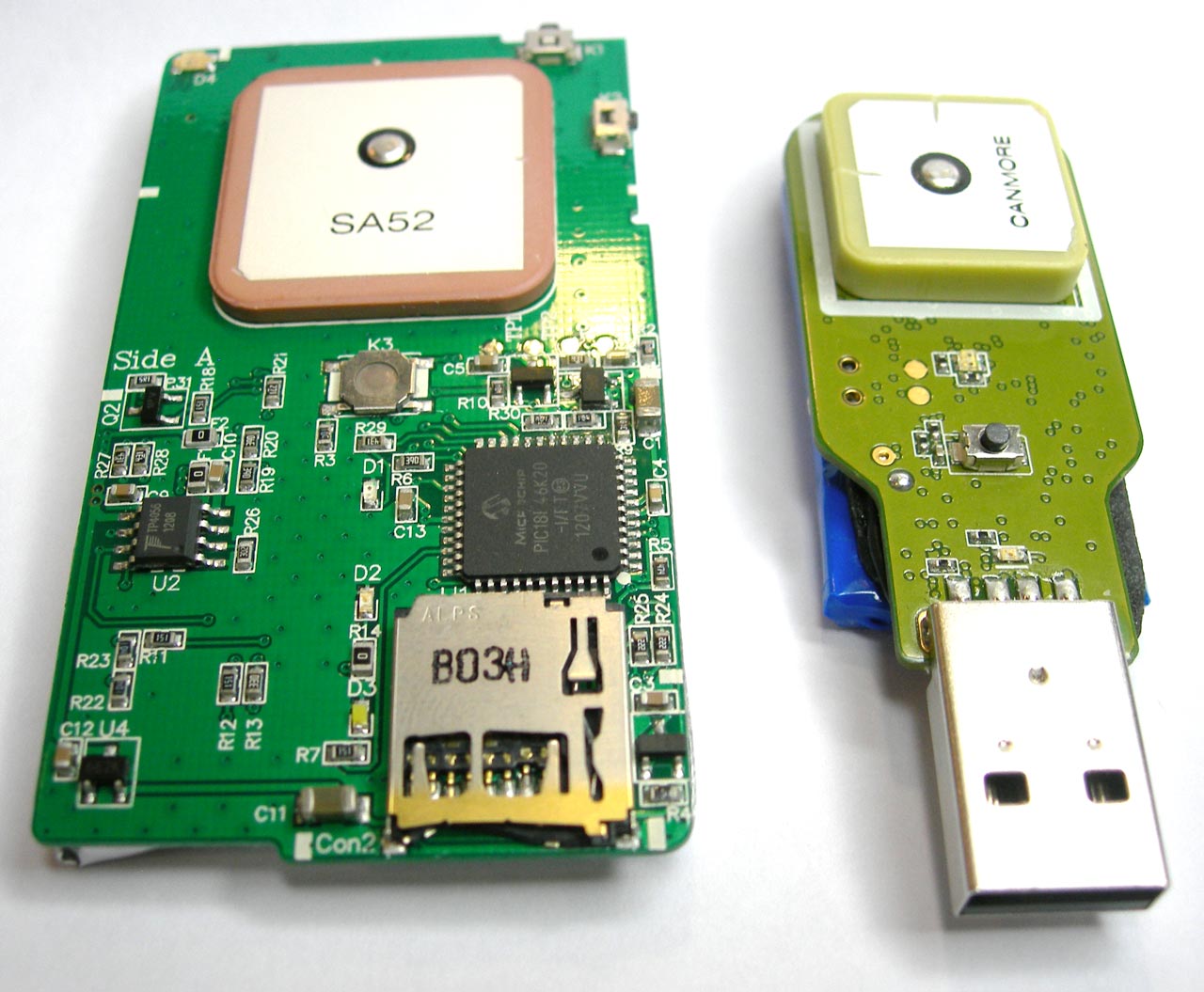
As you can see, the Columbus patch antenna is slightly larger in area than its competitor. Perhaps this is due to the fact that the MediaTek GPS chip is combined with the antenna, whereas the SiRF has two separate devices. However, I may be wrong and, if so, then correct me in the comments.

An inquisitive eye will notice that the D + and D-connectors of the mini-USB connector are somewhere divorced, but, unfortunately, there is still no practical sense.

The lower left corner of the photo, square ~ 5 mm - this is the SiRF Atlas IV GPS chip.
And a couple more photos to assess the size:
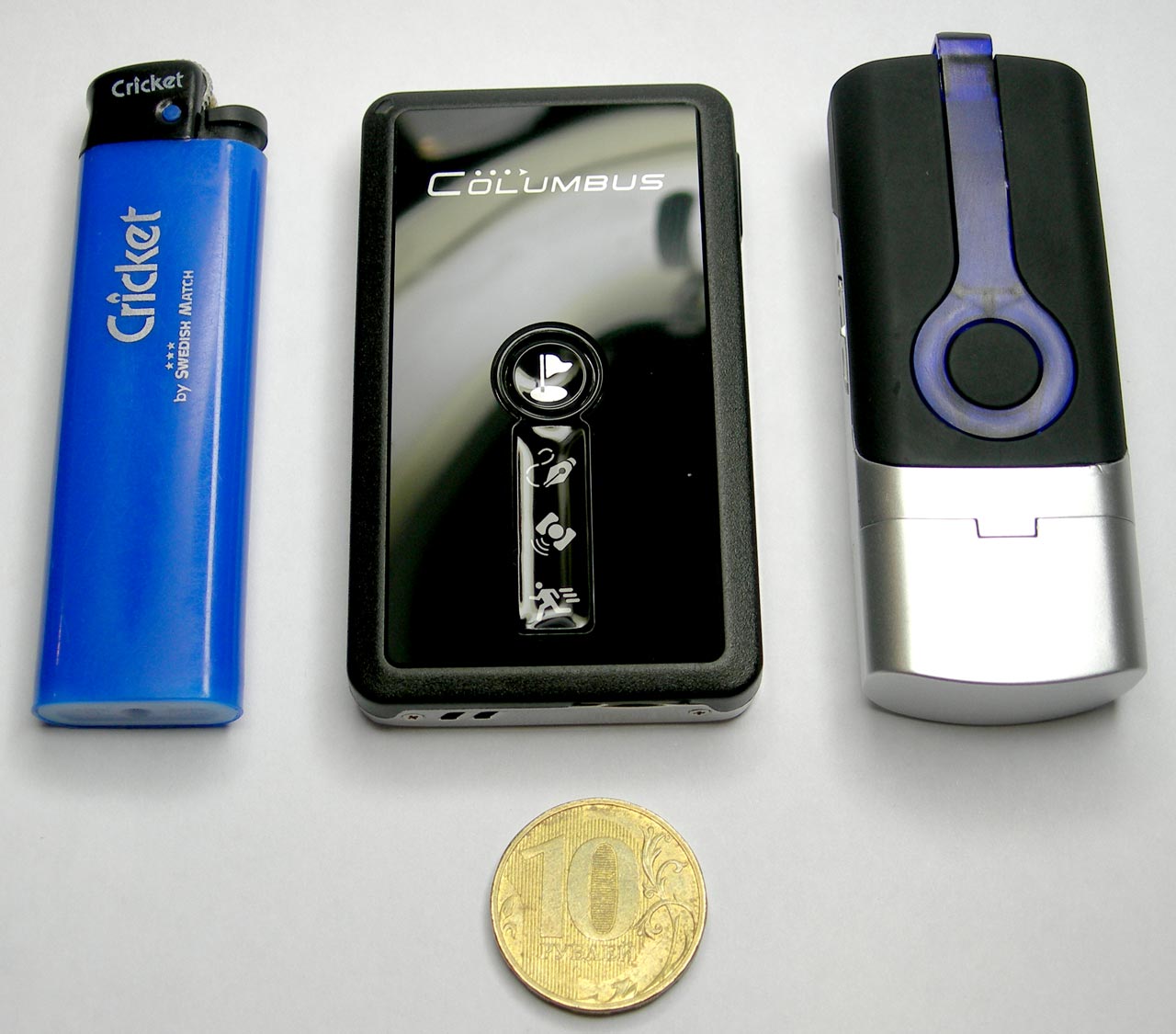
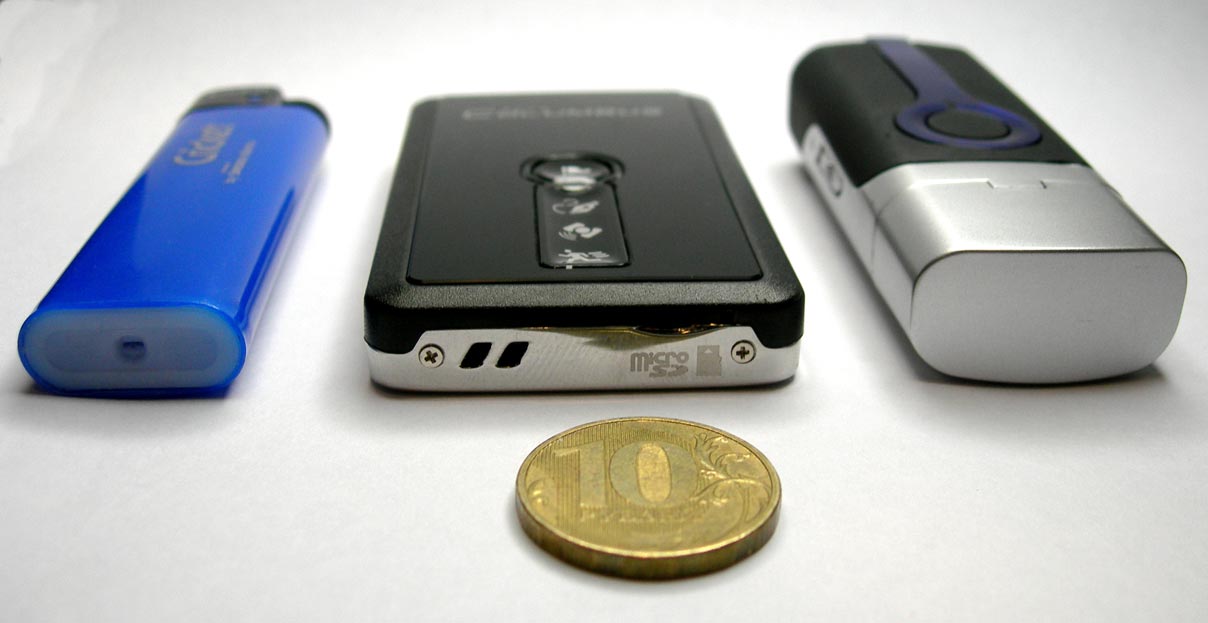
Now we will talk about the practical side of use and immediately in a comparative vein.
Columbus catches satellites in 40 seconds, Canmore - about three to five minutes. Columbus is more confident in “holding the track”, but it sometimes has problems with incorrect height determination (peaks up, mainly during the moments of establishing a connection with the satellite). Both devices are not without problems with the appearance of "anomalous" points (a sharp ejection to the side), however, they are infrequent and do not spoil the impressions as a whole. There is a difference with the definition of heights between these two devices:
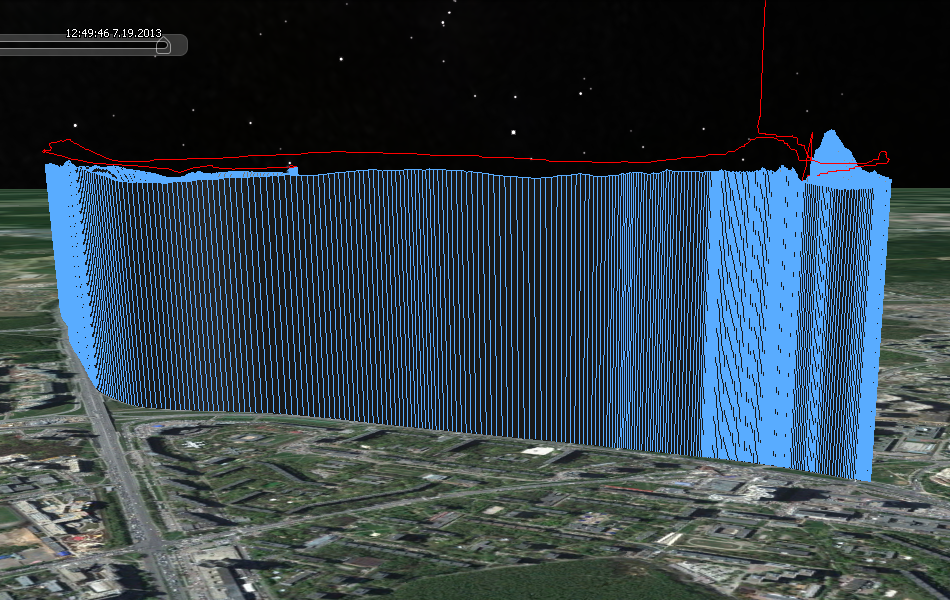
Blue - Canmore, red - Columbus. Noticeable difference in the definition of height and height jumps in the MTKII chip.
Unfortunately, I can't say more about the Canmore GT-730FL-S device. I got the device with a marriage (the battery does not charge), therefore I use only the data that I managed to accumulate.
POIs on Canmore are set at the moment of pressing, confirmation is triple blinking by LED, there is no soundtrack. Columbus is better in this regard, as there is a sound confirmation.
Columbus voice tags have a disgusting quality (I have already mentioned the reason above). Batteries in the mode of periodic recording of tracks are enough for a long time, and it is unlikely that someone will need to write without stopping a track lasting more than 5-6 hours. Is that in autotravel, but there is electricity at hand.
The moment of receiving data from the device is important. Columbus writes the track to a .csv file on a memory card, and adds voice tags (.wav files) to the same place. It is converted easily, and there are enough ready-made solutions .

The TAG: T column is a regular point, C is POI, V is a voice tag (VOX column is a file name with a voice tag, without an extension).
Reading the data from the map and converting them is not difficult in almost any modern OS, and this is another huge plus for Columbus.
Since I am a Winducer, I didn’t have problems with installing a driver and reading data from Canmore, but I don’t know how to be followers of other OSes. If you know, then write in the comments. I am sure that the solution will be useful to many.
That seems to be all. In general, I liked both devices, but none of them seemed to be perfect.
For those interested, I post two demo tracks and an example of a voice tag of Columbus, one from each device. I adjusted the tracks a bit (cut off the excess) so that they started and ended at the same time. I got out of the subway (with working loggers in a shoulder bag), got to the bus stop, waited for the bus, drove to work, got out and walked to the checkpoint. I think, on these tracks, everyone will be able to evaluate for himself the work of one or another GPS chip.
PS If I may, then I would describe my vision of the perfect hiking logger :
- operation from one battery of “AA” size or from one or two batteries of “AAA” size;
- the ability to install a memory card format micro-SD;
- the presence of a conveniently located POI button, setting a point on a track by simply pressing it, confirming with a sound signal;
- the presence of an LCD screen with the display of the number of satellites currently received, the current time (to synchronize the time shift in the camera) and the battery charge level (4-5 segments are enough);
- GPS chip MTK 3329 or more modern, preferably with GLONASS support.
- IPX7 water protection;
If you know a device that combines all these characteristics, then immediately inform me!
Source: https://habr.com/ru/post/187148/
All Articles